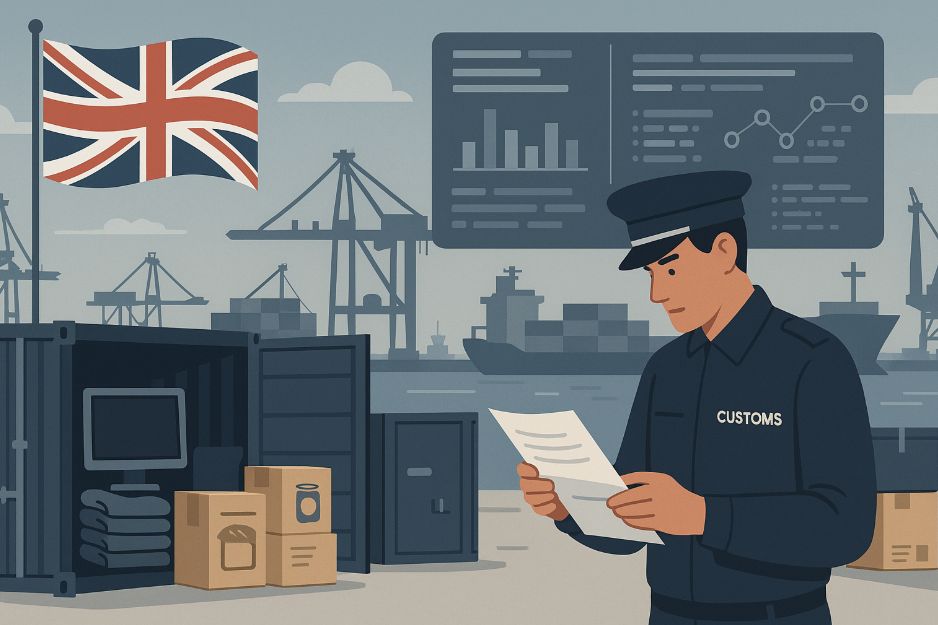In the intricate world of international trade, one of the most critical requirements is assigning the correct HMRC commodity code to every product. This classification code is not just for administrative purposes it determines the customs duties payable, applicable VAT, and whether any specific licences or restrictions apply.
Every business engaged in cross-border trade with the UK must ensure accurate product classification. Incorrect or vague entries can lead to delayed shipments, overpayment or underpayment of duties, and even financial penalties or regulatory actions from HM Revenue & Customs (HMRC).
This guide provides an in-depth look at commodity codes, how to use them properly, and how they directly affect your import/export process.
What Are HMRC Commodity Codes?

HMRC commodity codes are ten-digit numerical codes used in customs declarations. They follow a global system known as the Harmonised System (HS), created by the World Customs Organization (WCO). The UK adapts this into its own format often referred to as the UK Global Tariff (UKGT) which includes additional digits specific to national requirements.
Why HMRC Commodity Codes Are Essential ?
Correct classification ensures:
- Accurate calculation of customs duties and VAT
- Identification of any import or export restrictions
- Compliance with international trade agreements
- Avoidance of fines, audits, or border delays
Inaccurate or misleading codes can lead to investigations by HMRC, seizure of goods, or backdated tax liabilities problems no business can afford.
How Do You Classify Your Product with the Correct Commodity Code?
To find the correct commodity code, traders must analyse:
- The composition of the product (e.g. metal, fabric, electronic)
- Its intended use (e.g. commercial vs household)
- How the item is manufactured or processed
- Any additional features (e.g. safety elements, embedded software)
Example: Classifying a Steel Garden Table
A steel garden table may seem straightforward, but its classification could vary depending on:
- Whether it’s collapsible or permanent
- If it includes accessories like glass tops
- Whether it’s considered “furniture for outdoor use” or “metal household goods”
Each of these factors can lead to a different commodity code, which in turn affects the duty payable.
Use the General Rules of Interpretation
These are a globally agreed set of rules that guide product classification. They help resolve ambiguities when a product could fit under multiple headings.
Where Can You Find the Official HMRC Commodity Code List?

The official platform for identifying commodity codes in the UK is the UK Integrated Online Tariff. This service allows users to:
- Search by product name or keyword
- Browse by commodity chapter (e.g. Chapter 64 for footwear, Chapter 84 for machinery)
- Access up-to-date duty rates and VAT information
- Check for trade restrictions and documentation requirements
This tool is critical for businesses to remain compliant and informed about changes due to trade agreements or policy updates.
What Is the Difference Between HS Codes, CN Codes, and Commodity Codes?
HS Code (Harmonised System)
- 6-digit code recognised globally.
- Basis for nearly all national customs classifications.
CN Code (Combined Nomenclature)
- 8-digit extension used by the European Union.
- Adds further granularity for EU trade policy and statistics.
UK Commodity Code
- 10-digit code used post-Brexit.
- Includes UK-specific rules for tax, duty, and restrictions.
Understanding the structure ensures traders don’t mistakenly apply EU codes post-Brexit, which could lead to non-compliance.
How Do Commodity Codes Affect UK Import and Export Duties?
Determining Duty Rates
Each commodity code corresponds to a unique combination of:
- Customs duty rate
- Import VAT
- Excise duty (if applicable)
- Trade remedy measures like anti-dumping duties
Impact on Trade Costs
Correct classification can mean the difference between paying:
- 0% duty (e.g. for certain tech products)
- Up to 12% duty (e.g. for textiles)
- Additional import licensing or safety checks (e.g. for chemicals or electronics)
Accurate codes also help businesses calculate landed cost, informing pricing and profitability decisions.
What Tools Can Help With Finding and Checking UK Commodity Codes?

Official and Commercial Tools
- UK Trade Tariff Tool Main official resource.
- Binding Tariff Information (BTI) HMRC provides binding decisions on request.
- Tariff Stop A UK-based commercial tool for advanced lookups.
- Trade Tariff API Ideal for integrating classification into ERPs or ecommerce systems.
These tools streamline customs processing, reduce the risk of misclassification, and improve efficiency.
What Are Some Common Mistakes to Avoid When Choosing a Commodity Code?
Using Inaccurate Descriptions
Products labelled vaguely or generically often get misclassified. Always provide exact technical descriptions, including composition and function.
Failing to Update Post-Brexit Codes
Many UK traders still rely on old EU CN codes. These may differ from the current UK Global Tariff codes and could result in compliance issues.
Misunderstanding Composite Items
If a product is made of several materials or serves multiple purposes, traders must classify it according to its essential character usually the dominant material or function.
How Can UK Businesses Get Help with Commodity Code Classification?
Government Support
- Tariff Classification Enquiry Service: For basic queries via HMRC.
- BTI Rulings: A formal request process with legal standing for classification.
Private Sector and Industry Bodies
- Customs brokers: Provide paid expert classification.
- Chambers of commerce: Offer support and workshops for exporters.
- Trade compliance consultancies: Can audit classifications and provide training.
Especially for large shipments or high-value goods, expert input is highly recommended.
Real-World Product Types and HMRC Commodity Codes
| Product Type | Commodity Code | Duty Rate | VAT Rate | Notes |
| Men’s Cotton Shirt | 6205 20 00 | 12% | 20% | Classified under woven textile apparel |
| Laptop Computer | 8471 30 00 | 0% | 20% | Often exempt from customs duty if originating from FTA countries |
| Ceramic Coffee Mug | 6912 00 48 | 6% | 20% | Watch for material (stoneware vs porcelain can differ) |
| Organic Honey | 0409 00 00 | 0% | 0% | Some goods like food may be VAT zero-rated |
| Bluetooth Wireless Earphones | 8517 62 00 | 0% | 20% | Electronics often carry 0% duty under ITA agreements |
| Synthetic Rubber Gloves | 4015 19 00 | 4% | 20% | Different rates for medical vs household types |
| Packaged Dried Mango Slices | 0804 50 20 | 8% | 20% | Depends on processing and additives |
| Office Desk (Wooden) | 9403 30 10 | 0% | 20% | Some furniture is duty-free from select countries |
| Framed Canvas Art | 9701 10 00 | 0% | 20% | Classification depends on originality and handcraft |
| Pet Food (Dog Biscuits) | 2309 10 31 | 0% | 20% | VAT may be reduced for certain animal foods |
| LED Light Bulbs | 8539 50 00 | 3.7% | 20% | Energy-efficient products may benefit from certain duty reliefs |
This table is designed to guide importers and exporters in understanding how variations in product type, materials, and source country influence classification and charges.
How Are HMRC Commodity Codes Evolving in the UK in 2025?

Adjustments Post-Brexit and Trade Agreements
As of 2025, the UK’s independent trade policies are now more clearly defined after several years of regulatory divergence from the European Union. HMRC has continued to adapt the UK Global Tariff (UKGT) based on new Free Trade Agreements (FTAs) with countries like India, Australia, and Canada. These agreements have led to adjustments in commodity codes, particularly in sectors such as:
- Agriculture and food: New codes reflecting relaxed quotas and preferential tariffs
- Technology and electronics: Simplified classifications for semiconductors and AI-related products
- Textiles and apparel: Modified codes under rules of origin conditions in new FTAs
Impacts for Traders
Businesses need to be proactive in reviewing their existing codes and updating ERP systems regularly to reflect these changes. The government now publishes quarterly updates to the tariff schedule to reflect FTA clauses, anti-dumping duties, and commodity reclassifications.
What Digital Innovations Are Supporting Commodity Code Compliance in 2025?
Integration of AI and Automation
HMRC has begun rolling out AI-driven classification systems that assist traders in accurately determining commodity codes through image recognition and natural language processing. These tools, now in pilot stages, aim to reduce human error and speed up customs declarations.
- Smart Tariff Lookup: Integrated directly with HMRC’s new digital customs platform, this tool provides real-time code suggestions based on product descriptions and trade data.
- Customs Compliance Dashboards: Businesses can now track classification accuracy, past errors, and BTI expiry timelines within one interface.
- API Expansion: More businesses are integrating with the HMRC Trade Tariff API to automate classification across product catalogues, reducing manual input errors.
These digital tools empower SMEs and large-scale importers alike to stay compliant while managing complex product ranges. In 2025, businesses that fail to digitise their compliance workflows may fall behind in efficiency and regulatory responsiveness.
How Can Uk Businesses Future-proof Their Trade Compliance With Commodity Codes?

Staying Ahead Through Proactive Trade Strategy
As the UK’s global trading position continues to evolve, businesses must go beyond simply reacting to tariff changes or compliance alerts. Future-proofing trade operations requires building internal processes, teams, and systems that prioritise classification accuracy, audit readiness, and regulatory awareness.
Invest in Regular Training
Ensure your staff are regularly trained on tariff updates, classification methodologies, and using digital tools like HMRC’s online tariff platform. Training reduces dependency on third parties and builds in-house expertise.
Schedule Code Reviews Annually
Treat your commodity code database like a financial audit schedule yearly reviews, especially after major trade announcements or industry changes. This is especially important for businesses introducing new product lines or importing in high volumes.
Leverage Binding Tariff Information (BTI) Proactively
For recurring imports or large consignments, don’t wait for a dispute to arise apply for BTI in advance. It provides legal protection and removes guesswork in classification.
Automate Wherever Possible
Use trade compliance software that integrates with your ERP or ecommerce platform. Automation not only accelerates workflows but reduces the risk of manual input errors across thousands of SKUs.
Monitor Trade Agreements and Policy Bulletins
Set alerts or subscribe to bulletins from:
- HMRC and gov.uk
- British Chambers of Commerce
- Department for Business and Trade (DBT)
This keeps your business aligned with tariff changes, preferential duty rates, and updated rules of origin.
In 2025 and beyond, the businesses that thrive in cross-border trade will be those that treat commodity code management not as a formality, but as a strategic pillar of operations. By aligning classification processes with broader digital transformation and compliance goals, companies can reduce costs, avoid risk, and unlock smoother access to international markets.
Conclusion
Getting HMRC commodity codes right is essential for UK businesses trading internationally in 2025. These codes affect duty rates, VAT, and compliance with customs regulations. With regular updates to the UK Global Tariff and new trade agreements, accurate classification is more important than ever.
By using official tools, seeking expert advice, and staying informed, businesses can reduce costs, avoid delays, and remain fully compliant. Treating commodity codes as a key part of trade strategy not just admin will help companies thrive in an evolving global market.
FAQs About HMRC Commodity Codes
What happens if I use the wrong HMRC commodity code?
HMRC may impose penalties, backdated duty charges, or even seize goods if misclassification is discovered during an audit or customs clearance.
Are the codes different for import and export?
No, the same classification structure is used, though specific requirements (e.g., licensing) may vary between imports and exports.
Can I get an official decision from HMRC on my product’s code?
Yes, through a Binding Tariff Information (BTI) application. It provides a legally binding decision valid for 3 years.
Do I need to update my codes annually?
Yes, at least review them annually, as changes to tariff schedules or trade agreements may impact duty rates and classifications.
What documents should I keep for classification proof?
Technical product sheets, customs records, and BTI decisions are essential for audits and disputes.
How can I integrate commodity codes into my ecommerce or ERP system?
HMRC’s Trade Tariff API allows for automatic retrieval and classification within software platforms.
What’s the easiest way to classify new products?
Start with the gov.uk tariff tool, consult a customs agent if needed, and consider applying for a BTI for high-volume products.









Leave feedback about this